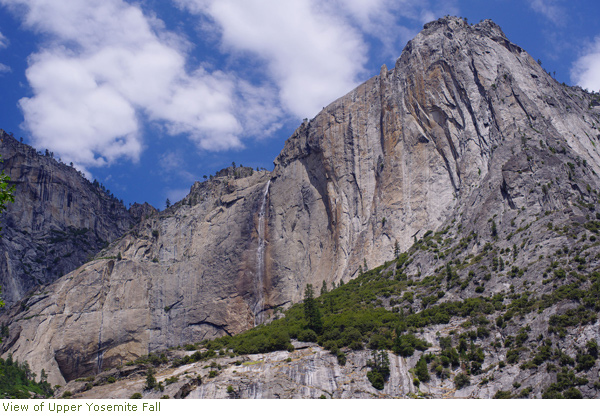The irony is that even the ephemeral forces leave their mark. With each pulse of water, there is a cycle of creation and destruction. Yosemite Falls cascades to the valley floor in three stages. After a 1400 foot plummet, the water reaches a platform where it briefly levels out and after a short flow through torturous rapids attempts to resume its mad dash toward the valley floor only to level out again. Freeing itself once more, it makes its final 320 foot drop.
These slowdowns and platforms are not happenstance. The platforms are horizontal joints exposed by the tireless work of water. The erosive force of water has been the instrument to create its own obstacles. Joints in the granite are weak points where the rock is more easily eroded. Though their exact cause is often a geologic mystery, these joints determine how the rock will be sculpted. The tendency to crack in these areas has also allowed plants to find a foothold in unlikely habitats.

Following the course of the waterfall itself, we can find even more tenacious inhabitants. Lichen, the union between algae and moss, proliferates. There are many types of lichen in Yosemite, and as with other plants each finds its preferred habitat. This phenomenon is particularly noticeable at Yosemite Falls where the different types of lichen from an outline of Yosemite Falls;each inhabiting its preferred stage of the "splash zone." Almost imperceptible when the falls are running, the lichens come to the forefront late in the summer, providing a tangible promise of a spring return.
The lichen themselves are dormant. Through the fall and winter they await the return of life-giving water. They do not just await a passive host;they are active agents in the erosive process. Lichen help break down the rock to create soil. Each one contributes just a little bit to the breakdown of these seemingly permanent rocks.
For humans whose attitude to rocks are well encapsulated by the phrase "as old as the hills" it is difficult to imagine the impacts of the slow work of water and lichen eventually causing the disappearance of the hills themselves. The native people in the valley have watched Yosemite Valley for at least 8,000 years. For them, it probably looked no different than it does to us today, but even the things that seem permanent to us are in fact ephemeral.
